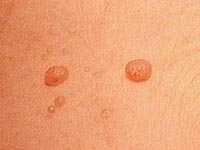Some consider the contagious mollusk one of the most common venereal diseases. But at the same time, this disease can often be observed in young children. How so it turns out? Let's figure it out.
Content
 Adults are most often infected with contagious mollusk at germ.
Adults are most often infected with contagious mollusk at germ.
In addition, the contagious mollusc virus can be transmitted when using one towel or a washcloth with patients, during sleep in one bed. There were cases of infection of contagious mollusk in swimming pools, especially in the pool infected children.
Children are infected «Skin» Mollusk through dirty hands, toys - and since this virus is passed quite easily, then in children's teams there may be whole epidemics of contagious mollusk. In contrast to many other viral infections, the prevalence of contagious mollusk does not depend on the geographical region, and the outbreak of the disease can be observed in all countries of the world.
Contingent Mollusca Pathogen - Pathogenic PolluscipoxVirus (Molluscipoxvirus), belonging to a group of obsolete viruses.
The contagious mollusc virus contains DNA, so it is impossible to get rid of it at the present stage of development of medicine. However, it is possible to make certain efforts to avoid recurrence of the disease: First of all, this refers to the protection and strengthening of the body's immune system.
The contagious mollusc virus is activated and makes itself felt by clinical manifestations, as a rule, when the patient's immune system is weakened by the action of adverse environmental factors, common diseases and other factors.
It depends on the path of contagious mollusk and its localization - that is, what kind of skin plots are affected by infection:
- in adults, when transmitting contagious molluscs, the outer genitals, crotch, pubis, lower abdomen, the inner surface of the hips are usually affected;
- As for children and infected by domestic by the adults, they do not have a certain localization of the contagious mollusk, and maybe the defeat of any skin sections.
However, in some cases, the rash of contagious mollusk can exist on the skin indefinitely. In this case of the development of infection, treatment is necessary, which is conducted by a dermatovenerologist.
However, the appeal to the doctor is necessary in any case. The fact is that, according to symptoms, the contagious mollusk can be confused with benign and malignant neoplasms on the skin, and only a specialist can carry out the differential diagnosis of contagious mollusk.
There is another reason to immediately appeal to the doctor: in adults, the contagious mollusk is quite often combined with HIV infection, so all patients with the contagious mollusk need to be examined for HIV. In addition, only the doctor will be able to determine whether the patient with contagious molluste needs in treatment, and appoints adequate therapy.









